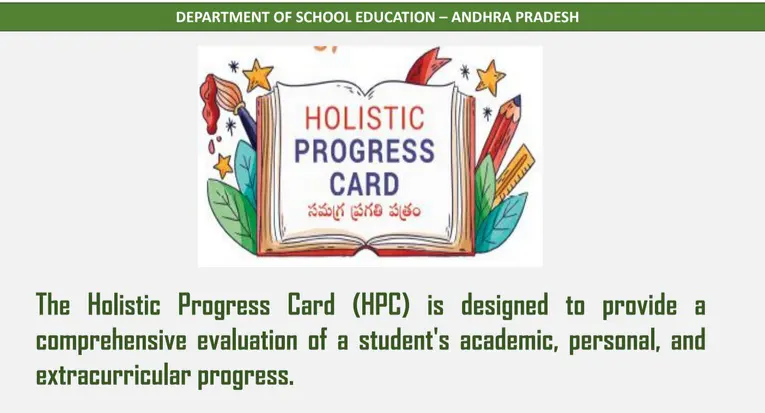Guide to Fill a Holistic Progress Report Card
The Holistic Progress Card (HPC) is a comprehensive evaluation tool designed to capture a student’s academic performance, personal growth, and extracurricular achievements. This guide simplifies the process, helping educators and stakeholders accurately complete the HPC while focusing on the overall development of the student. As per the guideline issued by the Dept of Education, teachers to give holistic progress card reports to parents during Mega Parents Meeting at school premises.

Key Objectives of the Holistic Progress Card
- Encourage holistic development by addressing academic, social, and emotional aspects.
- Document achievements in both curricular and co-curricular domains.
- Identify strengths and challenges to provide tailored support.
Step-by-Step Process to Fill the Holistic Progress Report Card
1. Basic Information and Student Profile
- Enter the student’s full name, date of birth, grade, and roll number.
- Add parental details and contact information.
- Include a recent photograph for identification.
2. Attendance Details
- Record the total number of school days and the student’s attendance percentage.
- Highlight any notable patterns or concerns in regularity.
3. Interests and Strengths
- List the student’s key areas of interest (e.g., sports, music, or specific subjects).
- Note their unique strengths and abilities as observed during the academic year.
4. Challenges and Support Needed
- Identify challenges faced by the student (academic, social, or emotional).
- Mention the interventions or support strategies provided (e.g., peer mentoring, resource materials).
5. Goals and Objectives
- Outline short-term and long-term goals set for the student.
- Mention the strategies or milestones to achieve these goals.
6. Academic Performance
- Formative Assessment: Record marks or grades for periodic assessments conducted during the term.
- Summative Assessment: Enter scores from term-end exams.
- Use visual aids like charts or graphs for clarity, if applicable.
7. Co-curricular Activities
- Document participation in sports, arts, debates, or other extracurricular events.
- Highlight achievements or special recognition received.
8. Annual Results
- Provide a consolidated summary of the student’s performance across the year.
- Include overall grades or remarks reflecting the student’s progress.
9. Holistic Observations
- Offer insights into the student’s behavior, social interactions, and emotional development.
- Use anecdotal notes to illustrate specific instances of growth or concern.
Tips for Filling the Holistic Progress Report Card
- Be concise yet descriptive, ensuring the details are meaningful and actionable.
- Collaborate with co-teachers, counselors, and parents for a well-rounded evaluation.
- Maintain a positive tone while addressing areas for improvement.
By following this step-by-step process, educators can ensure that the Holistic Progress Card provides a clear and comprehensive picture of the student’s growth, promoting targeted development and fostering potential.
Download Steps to Fill Holistic Progress Card by Dept of Edn AP Click Here